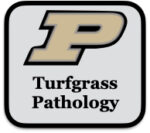Spring prep is done; Lawns: Seedhead season; Straight lines normally don’t = disease. Golf Putting Greens: Dollar spot rings in the season; Anthracnose inoculum building and soilborne pathogens lurking. Registration for Purdue Turfgrass & Landscape Field Day open!
Weather
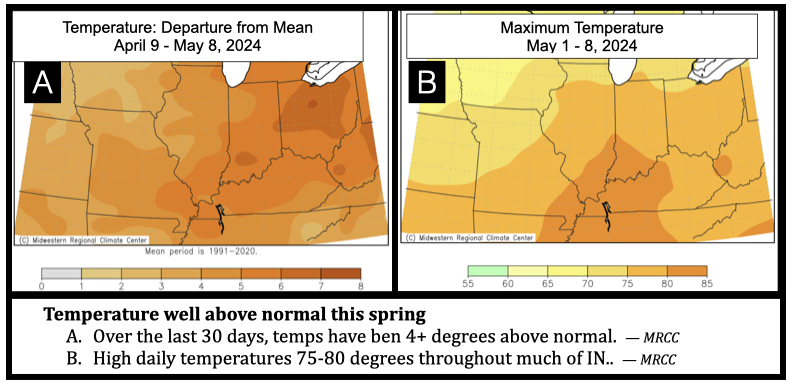
The 2024 spring oven must be gas lit because it preheated quickly. This spring remained 2-3 weeks ahead of schedule from the outset, yielding quick spring blooms, ongoing seedhead production from desirable turfgrass and weeds (such as Poa annua), and some early disease pressure in W. Lafayette prior to graduation. Crabgrass prevention should be down, at least the first fairy ring and soilborne disease preventive application on greens should be down, and dollar spot is already in full force throughout much of the state.
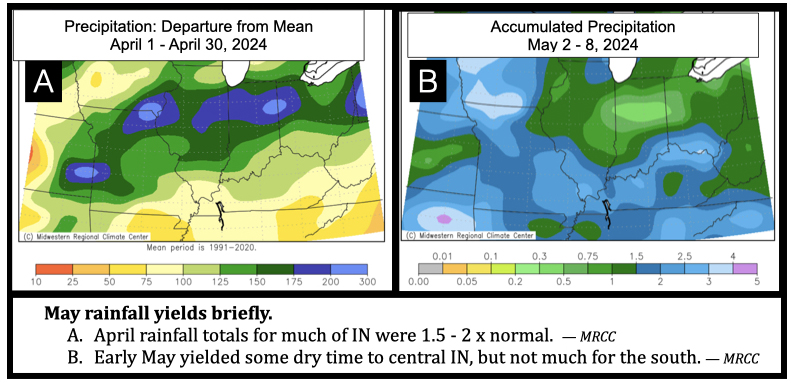
Consistent, sometimes overbearing, precipitation has also been common this spring. In Indy, 7.77” fell in April, nearly twice the average of 4.34”. After a slow start, over 0.5 fell in the Indy area over the last two days, with considerably more (2-3”) falling south along the Kentucky border into Cincinnati. The weather pattern is expected to be more of the same for the region through mid-May, with warmer than average temperatures accompanied by frequent opportunities for precipitation.
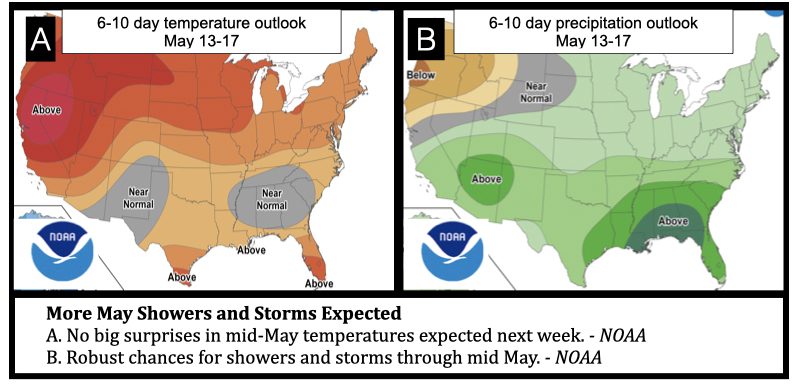
Lawns – It’s Seedhead Season
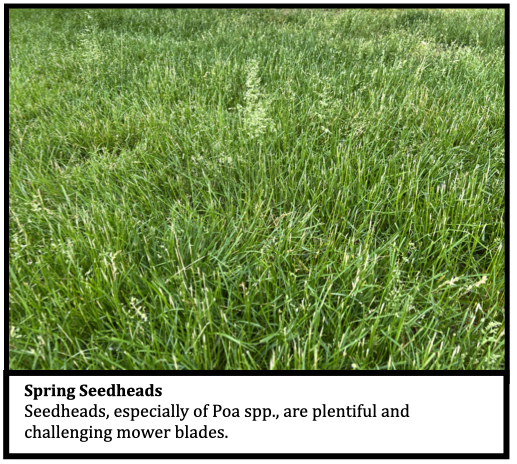
Seedheads, primarily of Poa spp such as Kentucky and annual bluegrass but also some fescues, are in full bloom now. Since seeding requires energy, seeding grasses are somewhat stressed, and some early stages of leaf spot have been observed on some seeding Kentucky bluegrass. Fortunately, top growth fueled by prime temperature and rainfall should outpace this early disease and seeding stress. These seedheads will let you know if your mower blades aren’t sharp. Also, lowering mowing height to cut more of the seedhead off is a poor idea since this will only reduce stand density more and allow more weed invasion. Instead, raise your mowing height now and throughout the season. If fertilizer hasn’t been applied yet feed the lawn a bit (~0.5 lb N/1000 sq ft) with a mid- to slow release fertilizer to keep density up and help the lawn box out and grab the board from opposing weeds.
Patterns Often Indicate Disorders, Not Disease
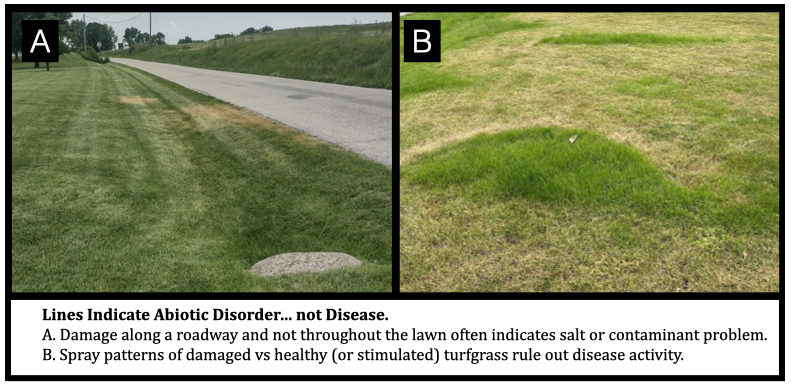
Over the last week, a few samples from homeowners have come into the Purdue PPDL. Although not always the case, the photos do tell the story. In photo A, no damage is to the lawn except for near the road. This is most likely due to salt or some other contaminant from the road impacting the lawn. Photo B is likely injury due to an application, either from a contaminant such as a non-selective herbicide mistakenly or maleficently added to the tank, or a miscalculation of too much adjuvant or product. These two photos provide clear reasons that we ask for digital images along with samples. Aside from aiding in these types of cases, diagnosing turfgrass diseases with both a microscope and observation of stand symptoms allows for a more accurate and useful diagnosis and recommendation for recovery.
Summer Patch Prevention on Kentucky Bluegrass
In areas with a previous history of summer patch, soil temperatures have reached the 65 F threshold in much of the state for prevention. Fungicides must be watered in with at least 0.2 – 0.25” of post application irrigation or rainfall to be effective. Also, fertilization with ammonium sulfate and/or manganese sulfate is recommended to supplement control. To see current soil temperature information for Indiana, click here.
Dollar Spot – Early to the Party in May
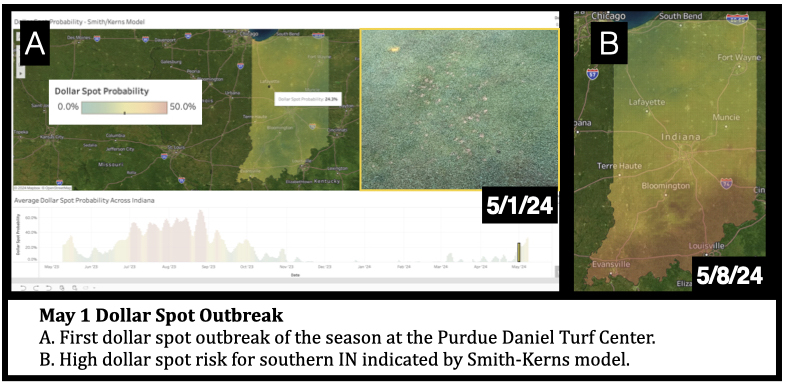
Our first outbreak of dollar spot on the research putting green at the Purdue Daniel Turfgrass Center arrived with the first May day this year. Keeping track, the first dollar spot was observed on May 29 in 2023, May 13 in 2022, and May 1 this year. All should realize that this research green presumably has the highest load of inoculum in all of Indiana due to years of research and artificial inoculation by Dr. Latin and now me. This being said, I would expect that much of southern and central Indiana would be observing dollar spot on bentgrass putting greens by now. In my experience, dollar spot on higher cut turf such as bentgrass fairways and Kentucky bluegrass sports field/lawns occurs a few weeks later into early June when the disease risk is sustained with a prolonged conducive environment and slower turfgrass growth. On higher cut (> 2”) Kentucky bluegrass, dollar spot can often be staved off with sufficient nitrogen fertilizer, whereas on bentgrass, annual bluegrass and other shorter cut turfgrass species, routine fungicide applications are necessary for management. Our research has shown that spring fungicide applications targeting soilborne pathogens can be a good start for controlling foliar diseases such as dollar spot, but will need reapplication within a normal 14-21 d interval. To see the Smith Kerns model output for Indiana, click here.
Golf: The Pathogen (Birds) are Pecking
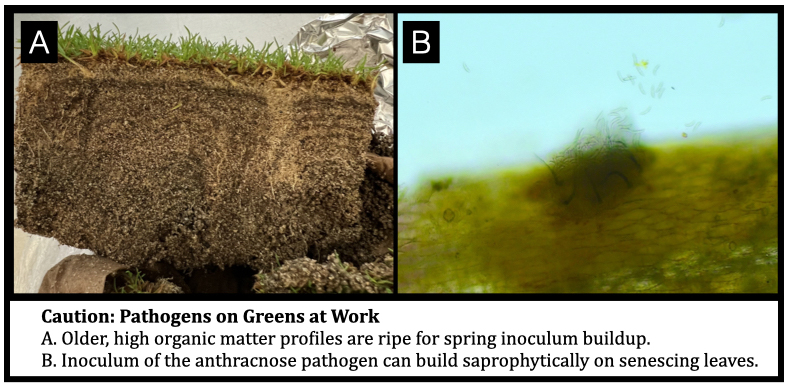
The flowers are blooming, birds are singing, grill smells are wafting, we are enjoying being out in our real offices, and leave it to the pervasively melancholy (“boogeyman”) pathologist to remind that the pathogens are lurking. On my scouting missions at the farm and on a few putting green samples, I’ve noticed several pathogens silently pecking away and building inoculum for a summer surge. In a few putting green samples submitted from central IN and from around Lafayette, ETRI (ectotrophic root infecting fungi) such as take-all and summer patch along with early infections of Pythium root rot have been observed. In these cases, no preventive fungicides were yet watered in this spring. For much of Indiana, soil temperatures eclipsed the 55-60 F mark for fairy ring prevention in late April/early May, and are now in the range for summer patch and Pythium root rot prevention. Indiana soil temperatures can be viewed here.
While rooting around putting green samples, anthracnose on older, senescing leaves has also been often observed on untreated areas. Easily forgotten is that leaves and roots of turfgrass plants are fairly short-lived (30-60 days). Degrading, older roots and leaf tissue eventually contribute to thatch and organic matter, but also provide a perfect food source for plant pathogens that have the ability to bat from both sides of the plate, and subsist on healthy, older, and dead plant tissue. This spring cycle, while cool-season plants are healthy and robust, allows for pathogen inoculum to build to a point where during the summer they can flip the switch and turn sour quickly when environmental conditions are also tough on the plant. Due to intense maintenance on putting greens, tolerance to infection is less and damage recovery is more difficult than in any other turfgrass system, hence disease prevention is the usual and necessary recourse.
REGISTRATION OPEN: Purdue Turfgrass and Landscape Field Day
– Tuesday, July 16th
The Purdue Turf and Landscape Field Day is an annual one-day event with the objective of providing professional turf and landscape managers exposure and educational opportunities with the latest research and technical resources. Field Day features research tours, talks on current topics, and a tradeshow with over 40 exhibitors displaying equipment, turf, and landscape products.
Turfgrass Pathology Program Impact Survey
Follow this link or scan QR code to access the survey.
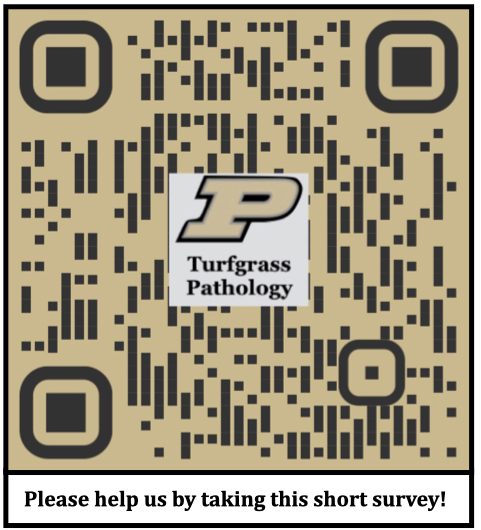
Lee Miller
Extension Turfgrass Pathologist – Purdue University
Follow on Twitter: @purdueturfpath
